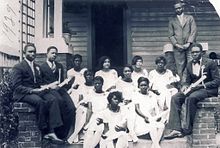
Zora Neale Hurston was an American author, anthropologist, and filmmaker. She portrayed racial struggles in the early-1900s American South and published research on hoodoo. The most popular of her four novels is Their Eyes Were Watching God, published in 1937. She also wrote more than 50 short stories, plays, and essays.

Tallahassee is the capital city of the U.S. state of Florida. It is the county seat and only incorporated municipality in Leon County. Tallahassee became the capital of Florida, then the Florida Territory, in 1824. In 2020, the population was 196,169, making it the 8th-largest city in the U.S state of Florida, and the 126th-largest city in the United States. The population of the Tallahassee metropolitan area was 385,145 as of 2018. Tallahassee is the largest city in the Florida Big Bend and Florida Panhandle region, and the main center for trade and agriculture in the Florida Big Bend and Southwest Georgia regions.

Leon County is a county in the Panhandle of the U.S. state of Florida. It was named after the Spanish explorer Juan Ponce de León. As of the 2020 census, the population was 292,198.

Seminole County is a county located in the central portion of the U.S. state of Florida. As of the 2020 census, the population was 470,856. Its county seat and largest city is Sanford. Seminole County is part of the Orlando-Kissimmee-Sanford, Florida Metropolitan Statistical Area.

Sanford is a city in the central region of the U.S. state of Florida and the county seat of Seminole County. As of the 2020 census, its population was 61,051.

Winter Springs is a city in Seminole County, Florida, United States. The population was 38,342 at the 2020 census. According to the 2019 Census Bureau estimates, the city has a population of 37,312. It is part of the Orlando–Kissimmee–Sanford Metropolitan Statistical Area.

Mary Jane McLeod Bethune was an American educator, philanthropist, humanitarian, womanist, and civil rights activist. Bethune founded the National Council of Negro Women in 1935, established the organization's flagship journal Aframerican Women's Journal, and presided as president or leader for a myriad of African American women's organizations including the National Association for Colored Women and the National Youth Administration's Negro Division.

Seminole State College of Florida is a public college with four campuses in Central Florida. It is part of the Florida College System.
Crooms Academy of Information Technology, locally called Crooms, is a technology magnet school located in Sanford, Florida, known for being one of the few schools in the United States that issues laptops to every student. Crooms is much smaller than many U.S. high schools, having around 700 students. The school is operated by Seminole County Public Schools.
The history of Tallahassee, Florida, much like the history of Leon County, dates back to the settlement of the Americas. Beginning in the 16th century, the region was colonized by Europeans, becoming part of Spanish Florida. In 1819, the Adams–Onís Treaty ceded Spanish Florida, including modern-day Tallahassee, to the United States. Tallahassee became a city and the state capital of Florida in 1821; the American takeover led to the settlements' rapid expansion as growing numbers of cotton plantations began to spring up nearby, increasing Tallahassees' population significantly.
The Florida education system consists of public and private schools in Florida, including the State University System of Florida (SUSF), the Florida College System (FCS), the Independent Colleges and Universities of Florida (ICUF) and other private institutions, and also secondary and primary schools as well as virtual schools.

Seminole County Public Schools (SCPS) is a public school district that covers Seminole County, Florida. As of September 2006, the total district wide enrollment was 66,351 students.

Blanche Mae Armwood (1890–1939), educator, activist and the first African-American woman in the state of Florida to graduate from an accredited law school. Armwood is also known for being the first Executive Secretary of the Tampa Urban League and as a founder of five Household Industrial Arts Schools for African-American women in five different states. Armwood High School in Seffner, Florida is named in her honor.
The Florida Association of Band Directors (FABD) was an organization dedicated to provide the music schools of predominantly black colleges in Florida, United States, with a feeder system from 1941 until 1966, when the organization merged with the Florida Bandmasters Association (FBA).

Goldsboro is a community and former town in Seminole County, Florida. It was founded by the Freedmen's Bureau and later incorporated in 1891. One of the oldest African-American founded communities in the United States, it was established only a few years after nearby Eatonville. Angola, Florida, a settlement of escaped slaves, was established during Spanish rule in Florida. In 1911, the community was annexed into Sanford, Florida.

Forrest Lake was a prominent politician, banker, real estate investor, a mayor of Sanford, Florida and a member of the Florida House of Representatives. Lake had an instrumental role in the formation of Seminole County. In 1928, Lake was convicted of embezzlement and served 3 years of a 14-year sentence.

Hopper Academy is a former school for African Americans in Sanford, Florida. It closed in the early 1960s, was used by the school district, and was then abandoned and fell into disrepair. It has been restored and is now a community center. It is on the Florida Black Heritage Trail and listed on the National Register of Historic Places.















